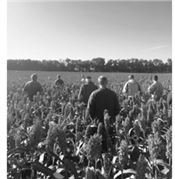Choosing A Sorghum Hybrid

DR. BRENT BEAN
LUBBOCK, TEXAS
During the winter, growers typically decide which hybrids to plant the following year. I am a person who does not particularly like change. My wife pokes fun at me for buying the exact type and brand of workshoe for the past several years. Why do I do this? Because from experience I know the shoes are comfortable, can stand up to a wide range of conditions and are a good value. However, when it comes to crop varieties, a grower who has consistently planted the same hybrid over the past several years is probably missing out.
Hybrids of grain sorghum historically have not changed as quickly as some other crops, but sorghum growers have seen more new hybrids introduced to the market over the past couple of years. Most companies will not bring a new hybrid to market unless the hybrid has some measurable advantage over other hybrids in their portfolios. This advantage could be better anthracnose resistance for the Midsouth, better drought tolerance for western Kansas or improved sugarcane aphid tolerance. As a group, these defensive traits protect the sorghum plants from pests or environmental stress.

Although these defensive traits are important, they mean little unless they improve overall grain yield. The best seed companies will not release a new hybrid if it does not improve yield by a certain percentage over hybrids that they already sell. A five percent increase in yield is a common threshold for most companies. Not only must this five percent threshold be reached at the company's breeding nursery, but it also must be a stable yield, meaning the yield is sustained over multiple environments.
Besides yield, standability is an important characteristic. In 2018, in many regions, growers experienced issues with standability, where sorghum lodging occurred primarily because the crop remained in the field many days after it had reached physiological maturity. The reason for this delay in harvest varied but was most often due to prolonged wet weather or the need to harvest other crops. Growers can take advantage of the years when lodging occurs by identifying those hybrids that maintain standability. Extension variety trial lodging ratings and visits with other growers about their 2018 standability experiences are valuable resources when choosing a sorghum hybrid.
In 2019, growers should consider planting at least two or three new hybrids and comparing them with the old variety. This practice is the best way to determine how a new hybrid will perform when grown on specific soils using a grower’s own farming practices. And while I am thinking about it, maybe it is time I try a new brand of shoe! ∆
DR. BRENT BEAN: USCP Agronomist